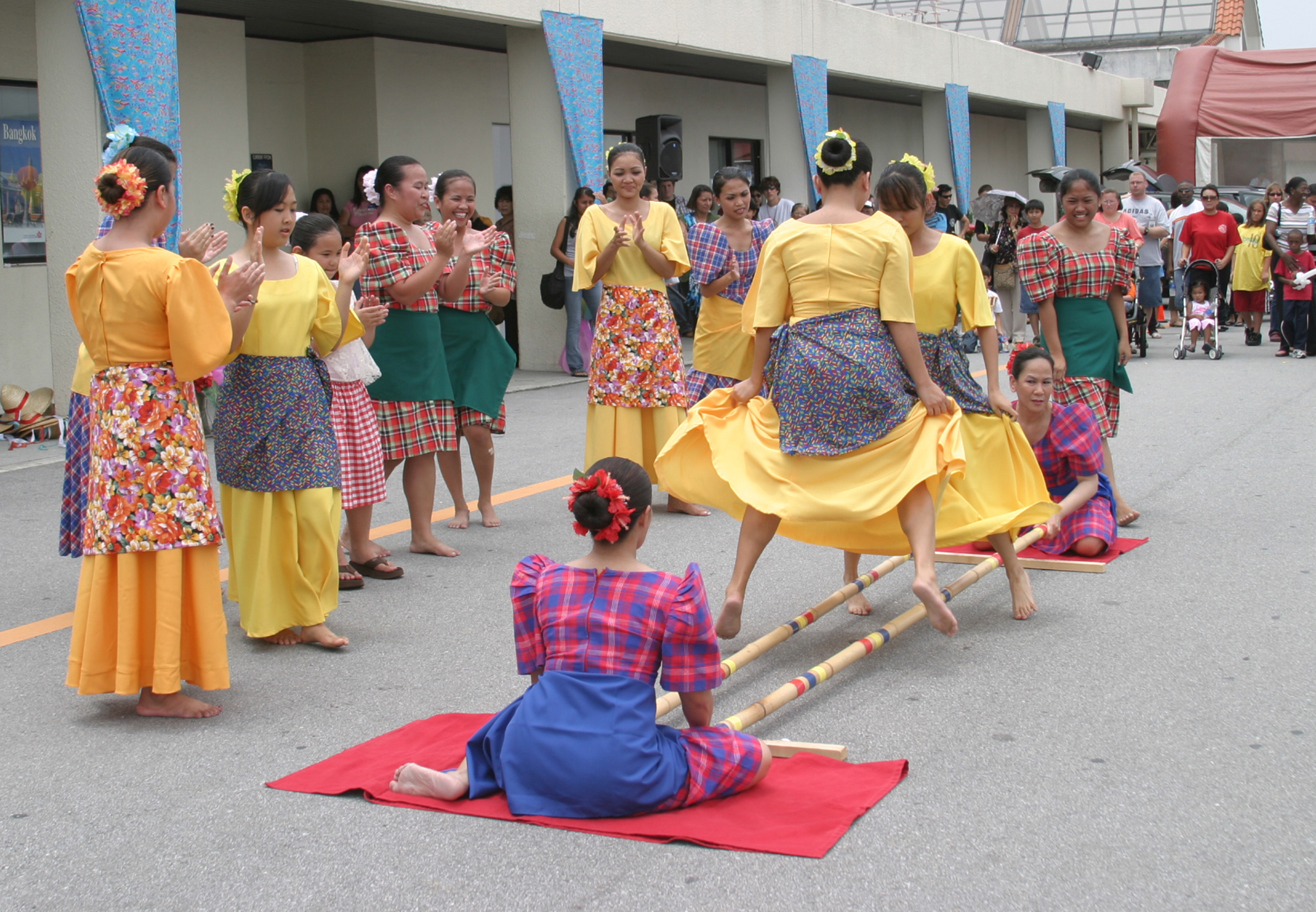|
Tinikling
Tinikling is a traditional Philippine folk dance which originated during the Spanish colonial era. The dance involves at least two people beating, tapping, and sliding bamboo poles on the ground and against each other in coordination with one or more dancers who step over and in between the poles in a dance. It is traditionally danced to rondalla music, a sort of serenade played by an ensemble of stringed instruments which originated in Spain during the Middle Ages. The locomotor movements used in tinikling are hopping, jumping, and turning. Origin The name ''tinikling'' is a reference to birds locally known as ''tikling'', which can be any of a number of rail species, but more specifically refers to the slaty-breasted rail ('' Gallirallus striatus''), the buff-banded rail ('' Gallirallus philippensis''), and the barred rail ('' Gallirallus torquatus''). The term ''tinikling'' literally means "to perform it ''tikling''-like." The dance originated in Leyte, Island in Visaya ... [...More Info...] [...Related Items...] OR: [Wikipedia] [Google] [Baidu] |
Tinikling
Tinikling is a traditional Philippine folk dance which originated during the Spanish colonial era. The dance involves at least two people beating, tapping, and sliding bamboo poles on the ground and against each other in coordination with one or more dancers who step over and in between the poles in a dance. It is traditionally danced to rondalla music, a sort of serenade played by an ensemble of stringed instruments which originated in Spain during the Middle Ages. The locomotor movements used in tinikling are hopping, jumping, and turning. Origin The name ''tinikling'' is a reference to birds locally known as ''tikling'', which can be any of a number of rail species, but more specifically refers to the slaty-breasted rail ('' Gallirallus striatus''), the buff-banded rail ('' Gallirallus philippensis''), and the barred rail ('' Gallirallus torquatus''). The term ''tinikling'' literally means "to perform it ''tikling''-like." The dance originated in Leyte, Island in Visaya ... [...More Info...] [...Related Items...] OR: [Wikipedia] [Google] [Baidu] |
Philippine
The Philippines (; fil, Pilipinas, links=no), officially the Republic of the Philippines ( fil, Republika ng Pilipinas, links=no), * bik, Republika kan Filipinas * ceb, Republika sa Pilipinas * cbk, República de Filipinas * hil, Republika sang Filipinas * ibg, Republika nat Filipinas * ilo, Republika ti Filipinas * ivv, Republika nu Filipinas * pam, Republika ning Filipinas * krj, Republika kang Pilipinas * mdh, Republika nu Pilipinas * mrw, Republika a Pilipinas * pag, Republika na Filipinas * xsb, Republika nin Pilipinas * sgd, Republika nan Pilipinas * tgl, Republika ng Pilipinas * tsg, Republika sin Pilipinas * war, Republika han Pilipinas * yka, Republika si Pilipinas In the recognized optional languages of the Philippines: * es, República de las Filipinas * ar, جمهورية الفلبين, Jumhūriyyat al-Filibbīn is an archipelagic country in Southeast Asia. It is situated in the western Pacific Ocean and consists of around 7,641 islands t ... [...More Info...] [...Related Items...] OR: [Wikipedia] [Google] [Baidu] |
Maglalatik
The ''Maglalatik'' (also known as ''Manlalatik'' or ''Magbabao'') is a folk dance from the Philippines performed by male dancers. Coconut shell halves are secured onto the dancers' hands and on vests upon which are hung four or six more coconut shell halves. The dancers perform the dance by hitting one coconut shell with the other; sometimes the ones on the hands, the ones on the body, or the shells worn by another performer, all in time to a fast drumbeat. Maglalatik can be seen as a mock battle between the dancing boys. The dance is intended to impress the viewer with the great skill of the dancer. In some "Filipino Martial Arts" (FMA) circles, it is noted that the ''Maglalatik'' "consists of a trapping and boxing method hidden in a dance." The name of the dance means "latik-maker", from latik, a coconut product that is used in Filipino cooking. The dance is also a war dance depicting a fight between Moros and Christians over the latik. References See also *Music of the Ph ... [...More Info...] [...Related Items...] OR: [Wikipedia] [Google] [Baidu] |
Leyte
Leyte ( ) is an island in the Visayas group of islands in the Philippines. It is eighth-largest and sixth-most populous island in the Philippines, with a total population of 2,626,970 as of 2020 census. Since the accessibility of land has been depleted, Leyte has provided countless number of migrants to Mindanao. Most inhabitants are farmers. Fishing is a supplementary activity. Rice and corn (maize) are the main food crops; cash crops include coconuts, abaca, tobacco, bananas, and sugarcane. There are some manganese deposits, and sandstone and limestone are quarried in the northwest. Politically, the island is divided into two provinces: (Northern) Leyte and Southern Leyte. Territorially, Southern Leyte includes the island of Panaon to its south. To the north of Leyte is the island province of Biliran, a former sub-province of Leyte. The major cities of Leyte are Tacloban, on the eastern shore at the northwest corner of Leyte Gulf, and Ormoc, on the west coast. Leyte ... [...More Info...] [...Related Items...] OR: [Wikipedia] [Google] [Baidu] |
Bandurria
The bandurria is a plucked chordophone from Spain, similar to the mandolin and bandola, primarily used in Spanish folk music, but also found in former Spanish colonies. Instrument development Prior to the 18th century, the bandurria had a round back, similar or related to the mandore. It had become a flat-backed instrument by the 18th century, with five double courses of strings, tuned in fourths. The original bandurrias of the Medieval period had three strings. During the Renaissance they gained a fourth string. During the Baroque period the bandurria had 10 strings (5 pairs). The modern bandurria has 12 strings (6 pairs). The strings are tuned in unison pairs, going up in fourths from the low G#. The lowest four strings are a major-third above those of a standard guitar and the highest two strings are a fourth above a standard guitar, i.e. G, c, f, b, e and a. File:bandurria1.jpg, Bandurria (front view) File:Bandurria2.JPG, Bandurria (back view) File:bandurria3.jpg, Bandurr ... [...More Info...] [...Related Items...] OR: [Wikipedia] [Google] [Baidu] |
Indonesia
Indonesia, officially the Republic of Indonesia, is a country in Southeast Asia and Oceania between the Indian and Pacific oceans. It consists of over 17,000 islands, including Sumatra, Java, Sulawesi, and parts of Borneo and New Guinea. Indonesia is the world's largest archipelagic state and the 14th-largest country by area, at . With over 275 million people, Indonesia is the world's fourth-most populous country and the most populous Muslim-majority country. Java, the world's most populous island, is home to more than half of the country's population. Indonesia is a presidential republic with an elected legislature. It has 38 provinces, of which nine have special status. The country's capital, Jakarta, is the world's second-most populous urban area. Indonesia shares land borders with Papua New Guinea, East Timor, and the eastern part of Malaysia, as well as maritime borders with Singapore, Vietnam, Thailand, the Philippines, Australia, Palau, and India ... [...More Info...] [...Related Items...] OR: [Wikipedia] [Google] [Baidu] |
KITLV - 25689 - Demmeni, J
The Royal Netherlands Institute of Southeast Asian and Caribbean Studies ( nl, Koninklijk Instituut voor Taal-, Land- en Volkenkunde, lit = Royal Institute for the Linguistics, Geography and Ethnology, abbreviated: KITLV) at Leiden was founded in 1851. Its objective is the advancement of the study of the anthropology, linguistics, social sciences, and history of Southeast Asia, the Pacific Area, and the Caribbean. Special emphasis is laid on the former Dutch colonies of the Dutch East Indies (now Indonesia), Suriname, and the Dutch West Indies (the Netherlands Antilles and Aruba). Its unique collection of books, manuscripts, prints and photographs attracts visiting scholars from all over the world. On July 1, 2014, the management of the collection was taken over by Leiden University Libraries. Jakarta In 1969, a KITLV office was started by Hans Ras in Jakarta ("KITLV-Jakarta"), as a part of an agreement with the Indonesian Institute of Sciences. Here, publications from Indones ... [...More Info...] [...Related Items...] OR: [Wikipedia] [Google] [Baidu] |
Pandanggo Sa Ilaw
Pandanggo is a Philippine folk dance which has become popular in the rural areas of the Philippines. The dance evolved from Fandango, a Spanish folk dance, which arrived in the Philippines during the Hispanic period. The dance is accompanied by castanets. This dance, together with the Jota, became popular among the ''illustrados'' or the upper class and later adapted among the local communities. In the early 18th century, any dance that is considered jovial and lively was called Pandanggo. Versions There are many versions of this dance and each locality has its own version. Local dancers have many ways of doing the Pandanggo, but there is one thing in common between different versions: they have gay and sprightly figures. It may be danced at any social gathering and is usually accompanied by clapping. In some places, the musicians do not stop playing until four to five couples have danced, one after the other. When one couple tires, another takes its place until there are no m ... [...More Info...] [...Related Items...] OR: [Wikipedia] [Google] [Baidu] |
Triple Metre
Triple metre (or Am. triple meter, also known as triple time) is a musical metre characterized by a ''primary'' division of 3 beats to the bar, usually indicated by 3 (simple) or 9 ( compound) in the upper figure of the time signature, with , , and being the most common examples. The upper figure being divisible by three does not of itself indicate triple metre; for example, a time signature of usually indicates compound duple metre, and similarly usually indicates compound quadruple metre. Shown below are a simple and a compound triple drum pattern. \new Staff \new Staff Stylistic differences In popular music, the metre is most often quadruple,Schroedl, Scott (2001). ''Play Drums Today!'', p. 42. Hal Leonard. . but this does not mean that triple metre does not appear. It features in a good amount of music by artists such as The Chipmunks, Louis Armstrong or Bob Dylan. In jazz, this and other more adventurous metres have become more common since Dave Brubeck's ... [...More Info...] [...Related Items...] OR: [Wikipedia] [Google] [Baidu] |

.jpg)



